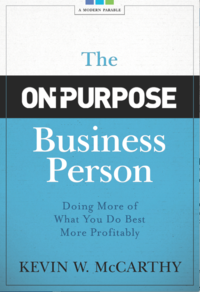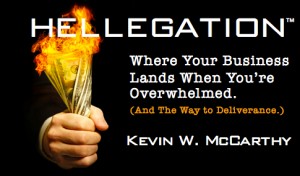Spread way too thin?
Does your “To Do List” look more like an “It’ll Never Get Done List”?
Welcome to my world where I have
- more ideas than time
- more projects than production capacity
- a willing work ethic that admittedly tends toward workaholism
Who in your life is asking you this question: “Just because we can, do we?”
As a business advisor who develops deep strategy and designs businesses, I’ve seen far too many entrepreneurs and business owners confuse their capacity to perform as their reason to perform.
“We can do that!”
Having the ability to do something isn’t necessarily a sound reason for actually taking it on. I’ve been learning to be far more judicious about what I do. I also keep an “Ideas” file. Placing my scribbles and thinking into notes and notecards tends to discharge the energy or the immediacy and provides a cooling off period where perspective can be gained and better judgments made about what matters most.
Admittedly this is easier to write about than to live into.
The phone rang from a new business advisory client. I took the call. The business was in a revenue freefall.
- Sales had dropped from $220 million to $70 million.
- The business fundamentals had changed.
- The unexpected death of the co-founders created chaos and confusion.
The young new family ownership was unprepared to lead or manage a business of this scale. Something had to change—fast!
The business had many functional strengths in operations, finance, facilities, brand, and such. Tremendous business capacity resided with relatively very sound infrastructure. They could do business, but could they remain in business?
Business is an inside-out reality.
What’s happening within the business is reflected outside the business. Customer engagement is important; however, it is leadership and management who create the means for that engagement to shrivel or thrive.
Marketing, in this case, had never been strategic. The deceased owner had a knack for it. Today, no one was at the helm with a feel for the business. In short, the company was in the midst of a very costly identity crisis that affected the internal culture and marketing. The customer experience suffered and very predictably, sales plummeted.
Working with the new owners and the hired president, we crafted a heartfelt purpose, vision, missions, and values. Then we partnered to develop a business plan. It rippled into a renewed marketing plan, sales plan, sales tools, sales training program, and field train-the-trainer program.
Let’s just say, probably a million dollars was invested in the entire project by the time we were ready to launch.
The relaunch date of the company was set. Company-wide months of thought, effort, and resources had been poured into this push to reinvigorate the business. A special convention was called to unveil the months of planning and preparations.
The week before the big relaunch, the company president attended a technology conference extolling the opportunities to be found in that industry, an unrelated business. The president, however, figured, “We have a loyal customer base and the capacity to attempt this. They’ll follow us.” This was true, but not wise.
Over my and his managers’ vigorous objections, he hurriedly hijacked the conference agenda, threw together a presentation of his vision, and launched a business concept (no support in place, mind you, to execute) to his 500-person sales force flown in and housed at the company’s expense.
Need I say more! The sales force wasn’t just confused, they were red-hot angry. It was as if a “bait and switch” had happened right before their eyes. The owner was playing around willy-nilly with their livelihoods.
The day after the “announcement,” the engagement with On-Purpose Business Advisors was mutually ended. The company could pursue what eventually proved to be—no big surprise—a very costly tangent that killed trust and momentum … and eventually put the company all but out of business.
Of course, this client had a host of people telling him not to do what he was doing. He just refused to listen and paid with his family’s business.
An idea alone, even a great idea, is never justification or rationalization for starting new initiatives, projects, or companies. In most cases, investing the same effort to launch something new is more wisely invested in updating, upgrading, and deepening what exists already.
Let the simplicity of the On-Purpose business approach guide you: Do More of What You Do Best More Profitably. A great exercise for new projects or businesses is to use The Service Model to design and develop your idea.
By capturing the essence of your thinking with a consistent approach, you will be more realistic.
Then file it away and give yourself a cooling off period. Later pull it out and evaluate it against the other opportunities, projects, and ideas you have.
Personal/Team Discussion: Show and read this On-Purpose Business Minute to your team and ask the following: Considering the many projects and opportunities on our plate, assess each against … Just because we can, do we?
The drive to make money and the capacity to produce are not predictors of customer acceptance. What lessons or stories do you have to share about leading the organization?


